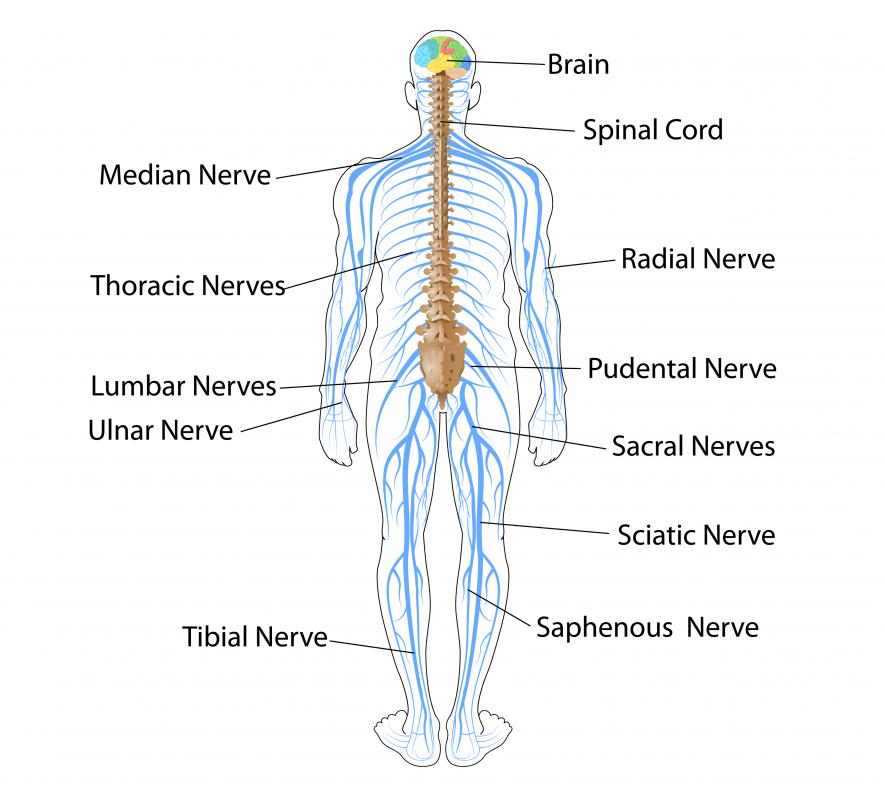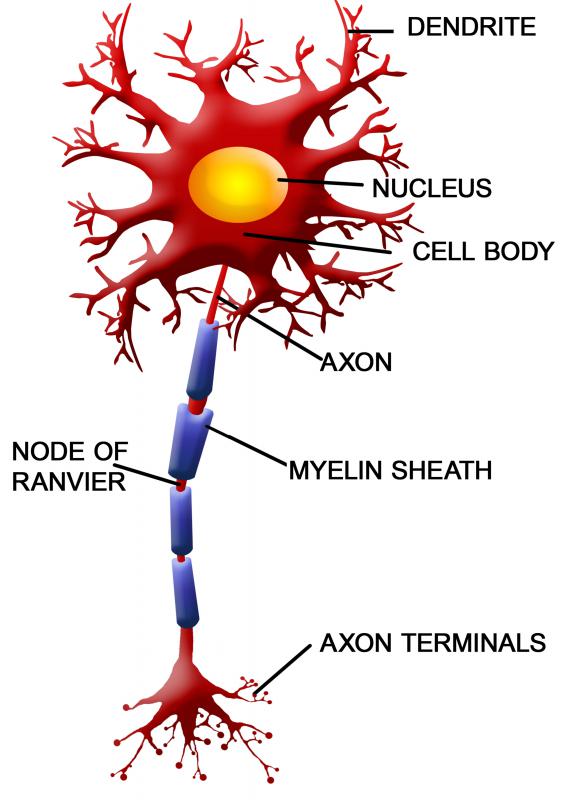At TheHealthBoard, we're committed to delivering accurate, trustworthy information. Our expert-authored content is rigorously fact-checked and sourced from credible authorities. Discover how we uphold the highest standards in providing you with reliable knowledge.
What Is the Function of White Matter in the Spinal Cord?
The function of the white matter in the spinal cord is to convey information from the nervous systems to the brain, or from the brain to the systems. The spinal cord is made up of grey matter and white matter. The grey matter is in the middle of the spinal cord, with four horns branching off from each corner that make it resemble the letter H, and surrounded by white matter. The four horns are called the dorsal horn, the lateral horn, the intermediate column, and the ventral horn column. Both white and gray matter contain nerve fiber bundles, called neurons, that convey impulses between the peripheral nervous system and the central nervous system.
The white matter contains neurons that carry the nerve impulses. These neurons are covered in a myelin sheath. The cord links the brain with the rest of the body, via the central nervous system, and sends the information along these nerve fibers to make the body function properly.

The fiber bundles contained in the white matter are called axons. They are coated with myelin, which is mostly lipid tissue filled with capillaries that insulates the axons and helps to speed them along. The fiber bundles contained in the grey matter are called dendrites and are covered with synapses. Axons are grouped into tracts that carry similar information.

Some tracts carry information from the white matter in the spinal cord to the brain and are called ascending tracts. These tracts are responsible for informing the brain what the fingers or other body parts feel. Other tracts travel from the brain to the other parts of the body and are called descending tracts. They might give orders for the muscles to move, or for the internal organs to perform their functions. It is the neurons' function in the spinal cord to convey the information that is either ascending up the tracts, or descending down the tracts.

The grey matter provides the communication between the central nervous system and the peripheral nervous system, which inclues the nerves outside the spinal column that serve other areas of the body. The neurons in the grey matter are unmyelinated, so they travel slower than the myelinated axons in the white matter.
AS FEATURED ON:
AS FEATURED ON:















Discussion Comments
@bluedolphin-- It's because of damage to both white and gray matter. Our spinal cord is very sensitive. In case of serious injury, if there is loss of blood circulation or a break in the cord, it causes damage to both white and gray matter. And as a result, motor control can be lost.
It make sense though right? White matter sends messages between the nerves to the brain and vice versa. If this cannot happen, movement cannot happen. Our brain can send directives all it wants, but without the white matter sending that information, our limbs can't move. Of course, in injuries, nerves can also be harmed, so loss of motor control can also be due to damage to nerves.
When people develop paralysis where they lose control of their limbs, is it because of damage to the white matter in the spinal cord?
Why can't paralysis be fixed? Is the spinal cord very sensitive?
As far as I know, there are some bacterial infections that can affect the white matter in the spinal cord if left untreated. If this happens, the infection can easily travel up to the brain. And the consequences can be severe, affecting the nervous systems and things like muscle control. This is why infections need to be taken very seriously and treated quickly.
But doesn't the gray matter do the same because of the dorsal horn contained within the gray matter that is in charge of ascending sensory information?
White matter is found on the edges of the spinal column and sends messages from the spine to the brain.
Post your comments